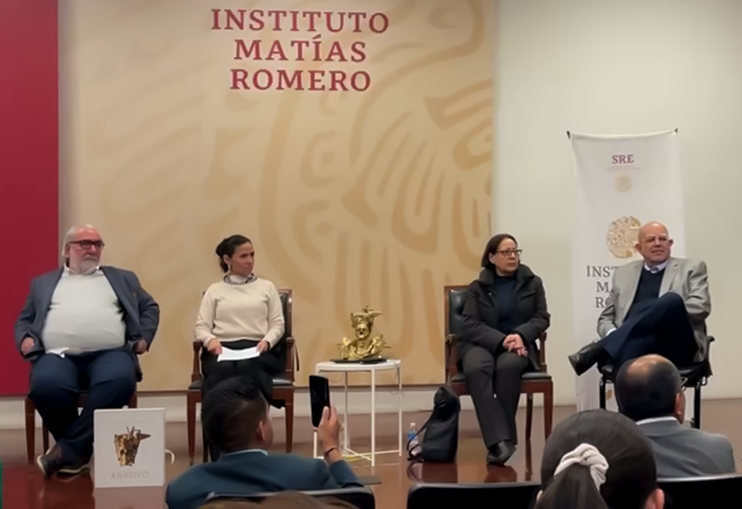
IT WOULD BE EASY TO TALK ABOUT DEATH…
5 de December de 2024
Text written by José Antonio Lugo for the presentation of the book Arroyo. Mexican Skull held at the Museum of the Foreign Ministry on November 27, 2024.
What happened to my friend
will happen to me!
I took a long road and wander the steppe.
What happened to my friend
will happen to me!
I embarked on a distant journey
and wander the steppe.
How could I remain silent,
how could I stay quiet?
My friend, whom I loved,
has returned to the mud!
Enkidu, whom I loved,
has returned to the mud!
Shall I not succumb like him?
Will I never rise again?
Whoever wrote the Epic of Gilgamesh in Akkadian, 4,000 years ago, put into the mouth of the protagonist the astonishment, the bewilderment, and the fear of death. How could I stay silent?
As the great German writer Robert Walser says, one writes to silence fear.
To silence this fear, cultures and civilizations, without exception, have established their own relationship with death.
In Mesoamerica, we are fortunate, because instead of arriving at a place where some reach paradise and others hell, it is instead a passage, let’s say, toward another kind of life. That’s why there is no mourning, but rather celebration, homage, even a feast. We celebrate the life lived, we wish good luck, and even say to the departed: We’ll see you in November; I’ll have your mole and your mezcal ready…
On this swarm of images and archetypes, Perla Arroyo has performed, in the strictest sense, an act of magic. A magician is one who has all the materials at hand to, along with the inspiration that comes from above—whatever that means—create something new and imperishable.
It would be easy to talk about the extraordinary craftsmanship: the plasticine, the 3D prints, digital blueprints, fiberglass shells, lost-wax casting, the loving polishing. Perla Arroyo masters the technique and puts it at the service of imagination, as any great artist does.
It would also be easy to talk about death in different latitudes, about funeral rites, ranging from the pyre on the Ganges to the mountain in Narayama where families leave their living loved ones to die.
It would also be easy to talk about Mictlán.
What is deeper and more revealing is something else.
The extraordinary French novelist Michel Tournier taught us in one of his stories that repetition is something sacred. When one wants to repeat a kiss or a night of passion, love has emerged.
Repetition creates a tribute to what was perfect and is desired again, like the exquisite dish that makes us return to the same restaurant, even if it’s thousands of miles away.
Perla celebrates death. The archetype is fixed, but the possibilities for repetition, the ways in which that celebration is expressed, are infinite.
With these pieces, the artist re-sacralizes the archetype while simultaneously recreating it, bringing forth new depths, new perspectives, new hermeneutics. Everything is the same, but it is different.
Difference and continuity, as the great art critic, my teacher, Juan García Ponce would say.
Perhaps the piece that best defines this process is Coatlicue-Nefertiti, which integrates to form something new, which is also the same.
With her powerful magic, Perla Arroyo opens the conversation and brings us the Tehuana, Coatlicue, the Xoloitzcuintle, Sor Juana Inés de la Cruz, Coyolxauhqui, Diego and Frida, and with them, the obsidian, the butterflies, the heart, the dahlia, the hummingbird, and a long, long etcetera…
At the end of the book, Luis Ignacio Sáinz, with his playful erudition, brings us Orozco and Tamayo, Toledo and Margolles, Pedro Coronel and Felguérez, Federico Silva and Betsabé Romero to show us, as in the painting The Sunday Stroll in the Alameda, the Mexican artists who have gone for a stroll along the path of the symbolic and visual expression of death.
The Real Academia Española Dictionary says that “prodigy” is: “A special, rare, or exquisite thing in its line.”
Dear Perla, your six pieces are a prodigy. You tell us that the series is not closed, that there may be more.
As an admirer of your work, I congratulate you. I hope more pieces will continue the celebration through difference.
As a compatriot and joyous spectator, I thank you for restoring to the Mexican skull its sacred character.
Thank you very much.
José Antonio Lugo holds a degree in French literature, a master’s degree in comparative literature, and is a doctoral candidate in Aesthetic Theories. He has written and published more than a dozen books covering short stories, novels, literary essays, symbolic universes, Taichi, graphology, and Bach flowers. He is a founding member and general director of the publishing house El Tapiz del Unicornio.
BOLETÍN
* Llenado obligatorio para continuar
Al suscribir aceptas los términos, políticas y condiciones de este sitio web.
Podrás cancelar tu suscripción a través del correo que recibas de nuestra parte en el momento que desees.
